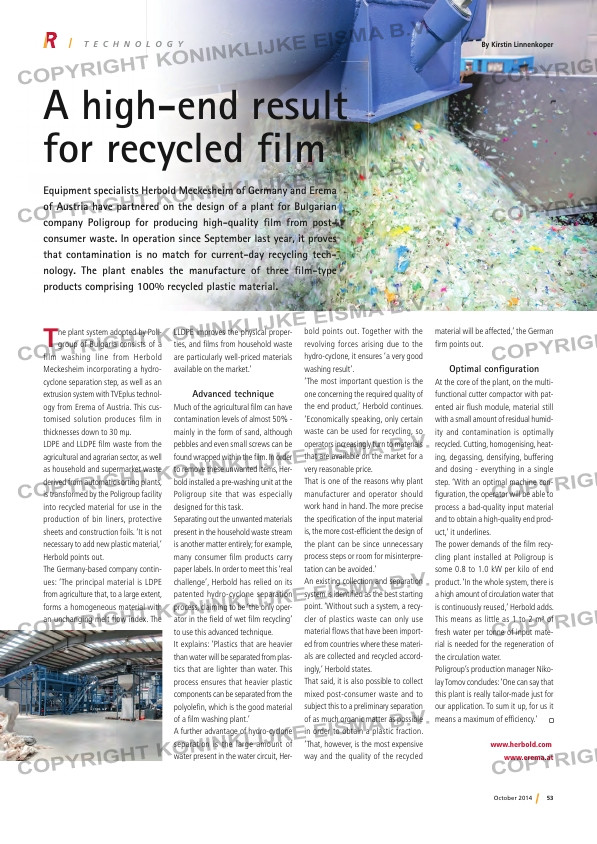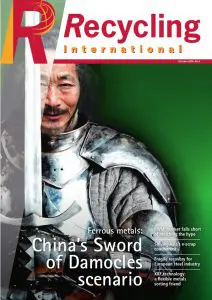Page 53 from: October 2014

53October 2014
A high-end result
for recycled film
Equipment specialists Herbold Meckesheim of Germany and Erema
of Austria have partnered on the design of a plant for Bulgarian
company Poligroup for producing high-quality film from post-
consumer waste. In operation since September last year, it proves
that contamination is no match for current-day recycling tech-
nology. The plant enables the manufacture of three film-type
products comprising 100% recycled plastic material.
The plant system adopted by Poli-group of Bulgaria consists of a
film washing line from Herbold
Meckesheim incorporating a hydro-
cyclone separation step, as well as an
extrusion system with TVEplus technol-
ogy from Erema of Austria. This cus-
tomised solution produces film in
thicknesses down to 30 mµ.
LDPE and LLDPE fi lm waste from the
agricultural and agrarian sector, as well
as household and supermarket waste
derived from automatic sorting plants,
is transformed by the Poligroup facility
into recycled material for use in the
production of bin liners, protective
sheets and construction foils. ‘It is not
necessary to add new plastic material,’
Herbold points out.
The Germany-based company contin-
ues: ‘The principal material is LDPE
from agriculture that, to a large extent,
forms a homogeneous material with
an unchanging melt fl ow index. The
LLDPE improves the physical proper-
ties, and fi lms from household waste
are particularly well-priced materials
available on the market.’
Advanced technique
Much of the agricultural fi lm can have
contamination levels of almost 50% –
mainly in the form of sand, although
pebbles and even small screws can be
found wrapped within the fi lm. In order
to remove these unwanted items, Her-
bold installed a pre-washing unit at the
Poligroup site that was especially
designed for this task.
Separating out the unwanted materials
present in the household waste stream
is another matter entirely; for example,
many consumer film products carry
paper labels. In order to meet this ‘real
challenge’, Herbold has relied on its
patented hydro-cyclone separation
process, claiming to be ‘the only oper-
ator in the fi eld of wet fi lm recycling’
to use this advanced technique.
It explains: ‘Plastics that are heavier
than water will be separated from plas-
tics that are lighter than water. This
process ensures that heavier plastic
components can be separated from the
polyolefi n, which is the good material
of a fi lm washing plant.’
A further advantage of hydro-cyclone
separation is the large amount of
water present in the water circuit, Her-
bold points out. Together with the
revolving forces arising due to the
hydro-cyclone, it ensures ‘a very good
washing result’.
‘The most important question is the
one concerning the required quality of
the end product,’ Herbold continues.
‘Economically speaking, only certain
waste can be used for recycling, so
operators increasingly turn to materials
that are available on the market for a
very reasonable price.
That is one of the reasons why plant
manufacturer and operator should
work hand in hand. The more precise
the specifi cation of the input material
is, the more cost-effi cient the design of
the plant can be since unnecessary
process steps or room for misinterpre-
tation can be avoided.’
An existing collection and separation
system is identifi ed as the best starting
point. ‘Without such a system, a recy-
cler of plastics waste can only use
material fl ows that have been import-
ed from countries where these materi-
als are collected and recycled accord-
ingly,’ Herbold states.
That said, it is also possible to collect
mixed post-consumer waste and to
subject this to a preliminary separation
of as much organic matter as possible
in order to obtain a plastic fraction.
‘That, however, is the most expensive
way and the quality of the recycled
material will be affected,’ the German
fi rm points out.
Optimal confi guration
At the core of the plant, on the multi-
functional cutter compactor with pat-
ented air fl ush module, material still
with a small amount of residual humid-
ity and contamination is optimally
recycled. Cutting, homogenising, heat-
ing, degassing, densifying, buffering
and dosing – everything in a single
step. ‘With an optimal machine con-
fi guration, the operator will be able to
process a bad-quality input material
and to obtain a high-quality end prod-
uct,’ it underlines.
The power demands of the fi lm recy-
cling plant installed at Poligroup is
some 0.8 to 1.0 kW per kilo of end
product. ‘In the whole system, there is
a high amount of circulation water that
is continuously reused,’ Herbold adds.
This means as little as 1 to 2 m³ of
fresh water per tonne of input mate-
rial is needed for the regeneration of
the circulation water.
Poligroup’s production manager Niko-
lay Tomov concludes: ‘One can say that
this plant is really tailor-made just for
our application. To sum it up, for us it
means a maximum of effi ciency.’
www.herbold.com
www.erema.at
T E C H N O L O G Y By Kirstin Linnenkoper
RI8-Film recycling.indd 53 06-10-14 14:10



